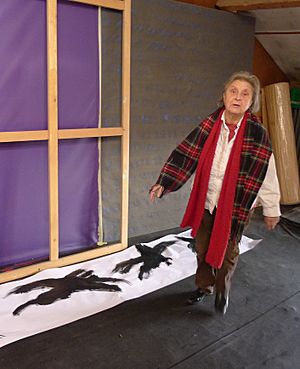Judit Reigl facts for kids
Judit Reigl (born Judit Némedy; May 1, 1923 – August 6, 2020) was a famous Hungarian painter. She lived most of her life in France.
Contents
Judit Reigl's Early Life and Studies
Judit Reigl went to the Hungarian University of Fine Arts from 1942 to 1945. There, she learned from a well-known painter named István Szőnyi. She won a special scholarship that allowed her to study in Italy between 1947 and 1948.
While in Italy, she saw many amazing artworks. She was inspired by old Byzantine art, the colorful mosaics in Ravenna, and paintings by famous artists like Giotto and Masaccio. She also admired the works of Giorgione and Titian in Venice.
Moving to France
In 1950, Hungary was behind the "Iron Curtain". This was a name for the strict border that separated Eastern Europe from Western Europe. Judit tried eight times to cross this border to get to Western Europe, and she finally succeeded!
She explained that in Hungary, she was only asked to paint pictures of the country's leaders, like Stalin, Rákosi, and Gerő. She felt she needed to leave to be truly free with her art. Judit traveled through Austria, Switzerland, Germany, and Belgium before reaching Paris. She lived in Paris from 1950 to 1963. Later, in 1963, she moved to Marcoussis, a town near Paris.
Her Artistic Journey and Influences
After arriving in Paris, Judit met another Hungarian artist, Simon Hantaï. In 1945, he introduced her to André Breton, who was a very important leader of the Surrealism art movement. Surrealism was all about dreams, imagination, and the unconscious mind. Breton really liked Judit's art and welcomed her into his group of Surrealist artists.
Judit was very interested in "automatic writing," a Surrealist technique. This is where artists create without thinking too much, letting their hands move freely. She said, "My entire body took part in the work... I wrote in the given space with gestures, beats, impulses." She became known for pushing this idea of automatic art, both in her mind and with her body.
Even though her Surrealist phase was short, Judit became a link between the Surrealists and younger artists. She later moved towards a style called Lyrical Abstraction. This style focuses on expressing feelings and emotions through colors and spontaneous brushstrokes. Georges Mathieu, a famous French Lyrical Abstractionist, was a big influence on her.
Judit's art became very popular in France, West Germany, and the United States. In the U.S., she learned about American Abstract Expressionists like Jackson Pollock, Willem de Kooning, and Franz Kline.
Judit Reigl's Artworks
Judit Reigl's early works from her Surrealist period often mixed photo collages with both real-life and abstract shapes. An example is her work Incomparable Pleasure (1952–53). She used pictures from magazines and newspapers in her collages. These collages fit the Surrealist style with their strange combinations and dream-like scenes.
Her paintings from this time were more abstract. They showed her first tries at automatic writing. Judit's automatic art came from her body's natural movements. It showed movement, floating, tension, and changes in rhythm on large canvases.
The Outburst Series
From 1955, Judit started a series called Outburst (Éclatement). For these, she used her body as her main tool. She would throw thick paint mixed with oil onto the canvas with her hands. Then, she would scrape it from the center to the edges with a tool. These paintings look like explosions of energy, bursting out from the middle. An Outburst from 1956 is in the Solomon R. Guggenheim Museum. Judit said this was a time when she moved away from the Surrealists.
Mass Writing and Guanos
For her next series, Mass Writing (Écriture en masse), Judit used a blade or stick to put large amounts of thick, black paint on the canvas. She then painted with upward strokes. The black areas spread out towards the edges of the canvas.
While working on these, she accidentally started a new series in 1958 called Guanos. For these, she used old canvases that had been covering her studio floor. The surfaces of these paintings looked like ancient ground. Judit herself said the canvases became "fertile ground" for new art.
Later Series
Some of her later series include Man, Drap/décodage, and Facing... (Face à...). These show her interest in exploring the human body and finding freedom from it. Other series, like Writings after Music (Écritures d'après musique) and Unfolding (Déroulement), were inspired by music. In Writings after Music, she turned musical notes into visual signs. The Unfolding series is like a dance, where she created unique visual art by combining movement and painting.
Exhibitions
Judit Reigl started showing her work in France in 1954. For her very first show, André Breton wrote the introduction in the exhibition book. Her paintings are mostly found in French museums, like the Musée d'Art Moderne de la Ville de Paris and the Musée National d'Art Moderne. Her art was only shown in Hungary starting in the mid-2000s.
She had many solo shows, meaning her art was the only one on display. Her first solo show was in Paris in 1954. She also had many group exhibitions, where her art was shown alongside other artists. These included important museums like the Solomon R. Guggenheim Museum in New York and The Metropolitan Museum of Art.
Awards
- Guggenheim International Award (New York City, 1964)
- Carnegie Award (Pittsburgh, 1967–68)
- Commander's Cross of Order of Merit of the Republic of Hungary (Budapest, 2008)
- Kossuth Prize (Budapest, 2011)
See also
 In Spanish: Judit Reigl para niños
In Spanish: Judit Reigl para niños


